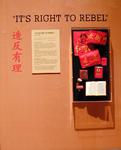
History of Cultural Revolution
Right to Rebel
On the Road
Living
Culture
Daily Life
Learning
The Countryside
Looking Back
Sidney Rittenberg Presentation
Links
 > View Large < |
"IT'S RIGHT TO REBEL"(196669) "We made a sacrifice for our ideals. If
you are born in one time, you should do your part." |
The Cultural Revolution started as an idealistic movement. Chairman Mao Zedong (18931976) had himself been a student activist. He urged students to create a new society through the destruction of the old. The guiding principle was "It's right to rebel."
RED GUARDS
The student Red Guards were the instruments of Mao's new revolution. Mao urged them to replace "poisonous" elements of the society with the revolutionary ideas found in his writings. The "Four Olds"old ideas, old culture, old customs, old habitswould be replaced by the "Four News."
DEGENERATES INTO VIOLENCE
But when Mao mobilized idealistic youth, he unleashed forces that quickly escaped control. Government officials and intellectuals were attackedboth verbally and often physicallyand objects of traditional Chinese culture were destroyed. From 1966 to 1969, the revolution spread throughout Chinese society. Revolutionary zeal was misused, diverted into factional battles and directed locally into personal attacks against innocent people.
This page
last updated
September 25, 2002
All material © 1998-2002
Burke Museum of Natural History & Culture
University of Washington, Box 353010
Seattle, WA 98195
This site best viewed at 800 x 600
using IE 5.0 or above.
